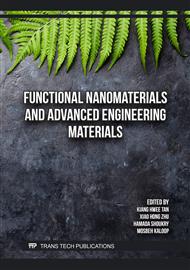[1]
Sharma, V.K., R.A. Yngard, and Y. Lin, Silver nanoparticles: Green synthesis and their antimicrobial activities. Advances in Colloid and Interface Science, 2009. 145(1): pp.83-96.
DOI: 10.1016/j.cis.2008.09.002
Google Scholar
[2]
Bindhu, M.R., et al., Structural, morphological and optical properties of MgO nanoparticles for antibacterial applications. Materials Letters, 2016. 166: pp.19-22.
DOI: 10.1016/j.matlet.2015.12.020
Google Scholar
[3]
Sridharan, B., et al., Synthesis of magnesium-based microparticles using oil cake of plukenetia volubilis (Inca fruit) seeds and study of its radical scavenging activity. Materials Today: Proceedings, 2022. 57: pp.887-891.
DOI: 10.1016/j.matpr.2022.02.569
Google Scholar
[4]
Hegazi, N.M., et al., Headspace Gas Chromatography/Mass Spectrometry Analysis Endorses Melaleuca Species as an Abundant Source of Medicinal Eucalyptol and its Proposed Anti-Obesity Activity. Egyptian Journal of Chemistry, 2022. 65(1): pp.607-618.
DOI: 10.21608/ejchem.2021.83718.4106
Google Scholar
[5]
Padalia, R.C., et al., The essential oil composition of Melaleuca leucadendra L. grown in India: A novel source of (E)-nerolidol. Industrial Crops and Products, 2015. 69: pp.224-227.
DOI: 10.1016/j.indcrop.2015.02.019
Google Scholar
[6]
Bean, A.R., Taxonomic notes on the Melaleuca leucadendra (L.) L. group (Myrtaceae) in Queensland. Austrobaileya, 2020. 10(4): pp.645-655.
DOI: 10.5962/p.299930
Google Scholar
[7]
Sharifi-Rad, J., et al., Plants of the Melaleuca Genus as Antimicrobial Agents: From Farm to Pharmacy. Phytotherapy Research, 2017. 31(10): pp.1475-1494.
DOI: 10.1002/ptr.5880
Google Scholar
[8]
Porusia, M. and D. Septiyana, Larvicidal activity of Melaleuca leucadendra leaves extract against Aedes aegypti. Caspian Journal of Environmental Sciences, 2021. 19(2): pp.277-285.
Google Scholar
[9]
de Araújo, M.J.C., et al., Acaricidal activity of binary blends of essential oils and selected constituents against Tetranychus urticae in laboratory/greenhouse experiments and the impact on Neoseiulus californicus. Experimental and Applied Acarology, 2020. 80(3): pp.423-444.
DOI: 10.1007/s10493-020-00464-8
Google Scholar
[10]
Ginting, B., et al., Identification of volatile compounds contained in the therapeutic essential oils from Pogostemon cablin, Melaleuca leucadendra, and Mentha piperita and their purified fractions. Journal of Advanced Pharmaceutical Technology & Research, 2023. 14(3).
DOI: 10.4103/japtr.japtr_161_23
Google Scholar
[11]
Pellegrini, L., et al. Information Modelling Management and Green Public Procurement for Waste Management and Environmental Renovation of Brownfields. Sustainability, 2021. 13.
DOI: 10.3390/su13158585
Google Scholar
[12]
Ahmed, S.F., et al., Green approaches in synthesising nanomaterials for environmental nanobioremediation: Technological advancements, applications, benefits and challenges. Environmental Research, 2022. 204: p.111967.
DOI: 10.1016/j.envres.2021.111967
Google Scholar
[13]
Lang, Y., et al., Classification and antioxidant assays of polyphenols: a review. Journal of Future Foods, 2024. 4(3): pp.193-204.
Google Scholar
[14]
John Sushma, N., et al., Facile approach to synthesize magnesium oxide nanoparticles by using Clitoria ternatea—characterization and in vitro antioxidant studies. Applied Nanoscience, 2016. 6(3): pp.437-444.
DOI: 10.1007/s13204-015-0455-1
Google Scholar
[15]
Sivapalan, S., et al., Evaluation of the anti-inflammatory and antioxidant properties and isolation and characterization of a new bioactive compound, 3,4,9-trimethyl-7-propyldecanoic acid from Vitex negundo. Journal of Ethnopharmacology, 2024. 319: p.117314.
DOI: 10.1016/j.jep.2023.117314
Google Scholar
[16]
Sarfraz, M.H., et al., Comparative analysis of phyto-fabricated chitosan, copper oxide, and chitosan-based CuO nanoparticles: antibacterial potential against Acinetobacter baumannii isolates and anticancer activity against HepG2 cell lines. Frontiers in Microbiology, 2023. 14.
DOI: 10.3389/fmicb.2023.1188743
Google Scholar
[17]
Diallo, A., et al., The essential oil of Melaleuca leucadendra L. (Myrtaceae) from Fatick (Senegal) as a source of methyleugenol. Composition, antibacterial and anti-inflammatory activities. Journal of Essential Oil Research, 2022. 34(4): pp.322-328.
DOI: 10.1080/10412905.2022.2067254
Google Scholar


